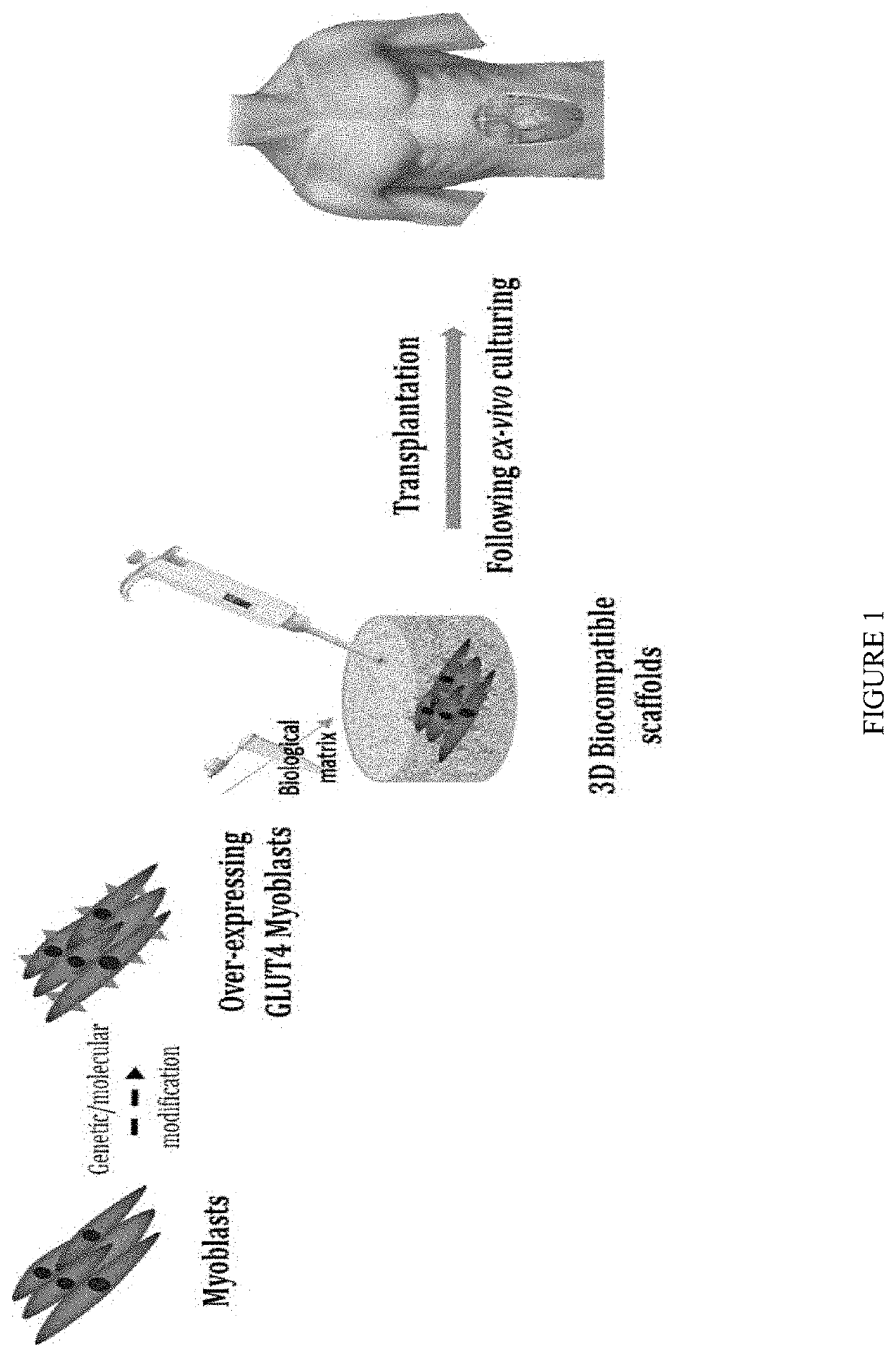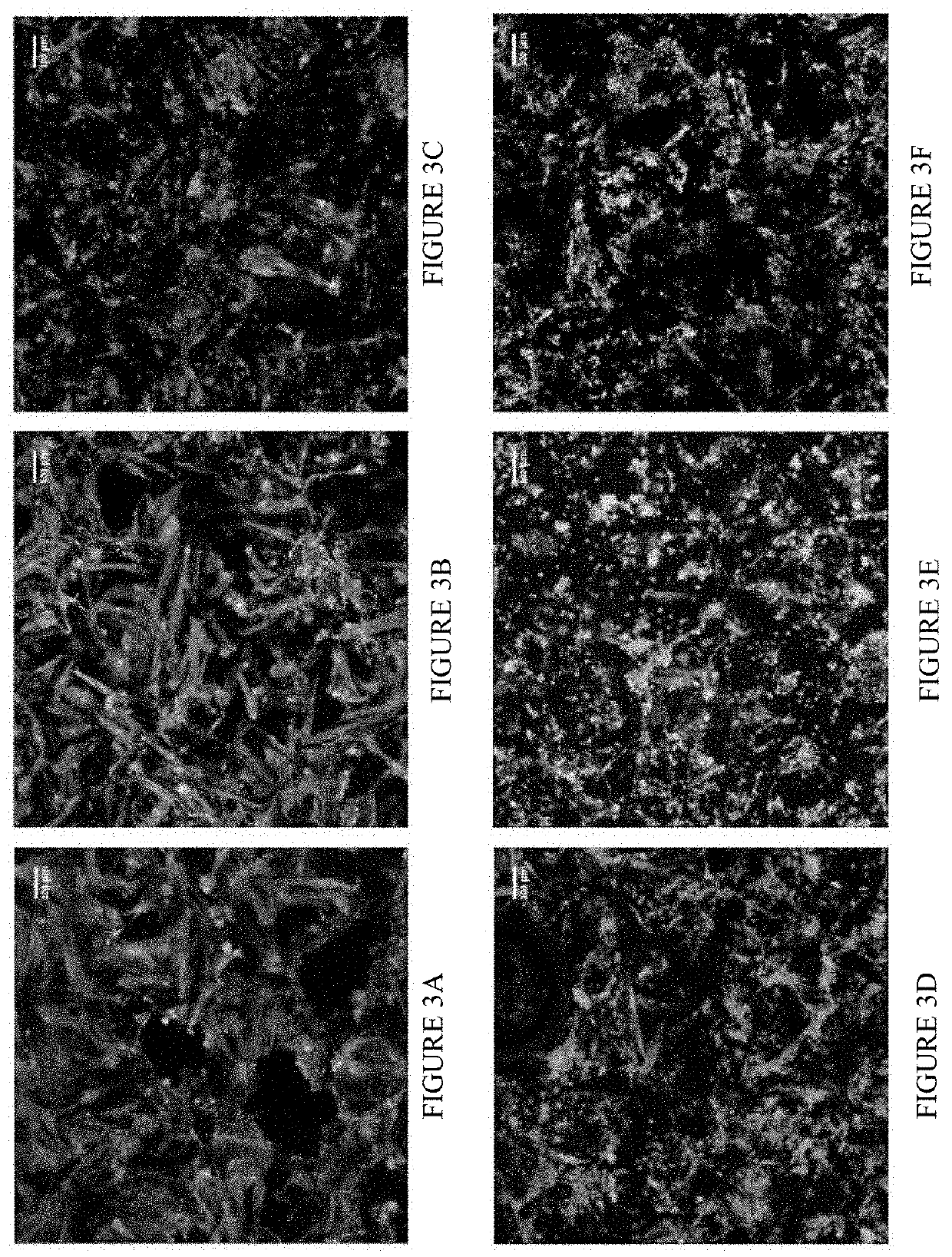Methods and compositions for treating and preventing diabetes
a technology of diabetes and composition, applied in the field of biomedical engineering, can solve the problems of increasing disability, reducing life expectancy, and enormous health costs, and achieve the effects of reducing glucose levels, increasing glut4 activity, and reducing glucose levels
- Summary
- Abstract
- Description
- Claims
- Application Information
AI Technical Summary
Benefits of technology
Problems solved by technology
Method used
Image
Examples
example 1
Morphology and Differentiation of Rat Skeletal Muscle Cells
[0174]Initially the myoblasts (skeletal muscle cells) were characterized for muscle morphology and ability to differentiate and form muscle fibers on the PLLA / PLGA scaffolds. L6WT and L6GLUT4 over-expressing cells were seeded at a concentration of 0.5×106 cells / scaffold, and grown for 1, 2 and 3 weeks in-vitro. Following the incubation period, whole scaffolds were fixated and stained for different myogenic markers and the presence of the glucose transporter GLUT4; Desmin: a muscle-specific type III intermediate filament; Myosin heavy chain (MYH): a motor protein of muscle thick filaments; and Myogenin (MYOG): a muscle-specific transcription factor involved in the coordination of skeletal muscle development, differentiation and repair.
[0175]The inventors demonstrated that as early as 1-week post seeding, L6 cells expressed the different myogenic markers, meaning the cells undergone differentiation and formed fibers on PLLA / PL...
example 2
Glucose Uptake Analysis In Vitro
[0177]To evaluate the glucose uptake ability of the three-dimensional constructs, a 2-[3H]-deoxyglucose (2DOG) uptake assay was performed. L6WT and L6GLUT4 myoblasts were seeded at a concentration of 0.25 or 0.5×106 cells / well in 12 well-plate and cultured for 1, 2 or 3 weeks. After the in-vitro culturing periods, scaffolds were incubated in either the absence or presence of insulin (Basal and Insulin levels, respectively), and afterwards 2DOG was added to the samples. 2DOG is an analog of glucose and is radioactively labeled with tritium (3H). The 2DOG has the 2-hydroxyl group replaced with hydrogen, so it cannot undergo further glycolysis, and thus its uptake can be quantified. 2DOG associated radioactivity was counted using a beta-counter.
[0178]Upon seeding of 0.25×106 cells per scaffold, the stimulated uptake by the L6GLUT4 cells was significantly higher compared to the basal uptake rate for L6GLUT4. No significant difference between the insulin s...
example 3
[0180]The animals used for the in-vivo experiments were RAG / MKR mice. These animals are immuno-deficient, having no mature B and T lymphocytes (RAG), and a genetically defective insulin receptor (MKR) leading to insulin-resistance and DM2 phenotype. Only males present the diabetic phenotype at the age of 8 weeks, and thus were implanted with a 6-mm scaffold, seeded with L6GLUT4 cells, in their abdominal muscle. In order to test the efficacy of the implants, a glucose tolerance test (GTT) was performed. The mice were injected i.p (intraperitoneal, injection into the body cavity) with a high dose (10% [w / v]) of glucose. It was shown by the inventors that due to their insulin resistance state, RAG / MKR mice, as oppose to their genetic background WT-FVBN counterparts, had a decreased tolerance for glucose and were unable to return to their basal glucose level (FIG. 8).
[0181]Eighteen (18) males at the age of 9-10 weeks were separated into 3 groups: 8 mice received co...
PUM
| Property | Measurement | Unit |
|---|---|---|
| diameter | aaaaa | aaaaa |
| diameter | aaaaa | aaaaa |
| porosity | aaaaa | aaaaa |
Abstract
Description
Claims
Application Information
 Login to View More
Login to View More - R&D
- Intellectual Property
- Life Sciences
- Materials
- Tech Scout
- Unparalleled Data Quality
- Higher Quality Content
- 60% Fewer Hallucinations
Browse by: Latest US Patents, China's latest patents, Technical Efficacy Thesaurus, Application Domain, Technology Topic, Popular Technical Reports.
© 2025 PatSnap. All rights reserved.Legal|Privacy policy|Modern Slavery Act Transparency Statement|Sitemap|About US| Contact US: help@patsnap.com



